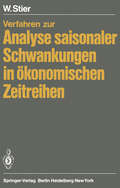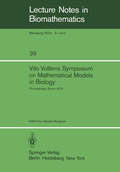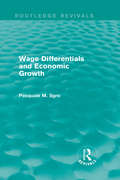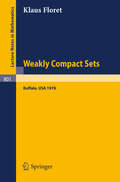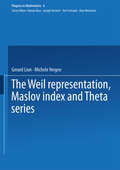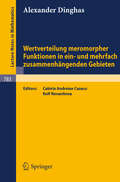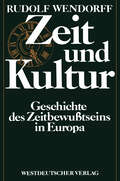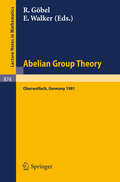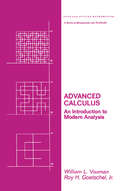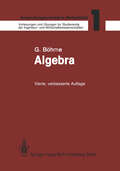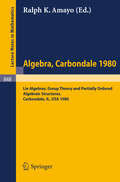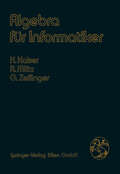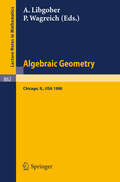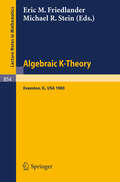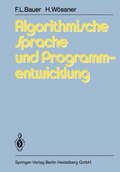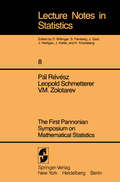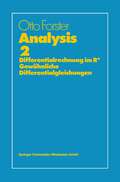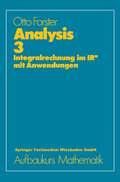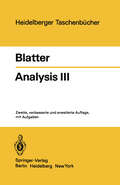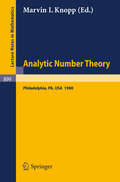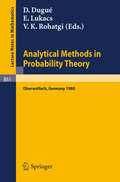- Table View
- List View
Vito Volterra Symposium on Mathematical Models in Biology: Proceedings of a Conference Held at the Centro Linceo Interdisciplinare, Accademia Nazionale dei Lincei, Rome December 17 – 21, 1979 (Lecture Notes in Biomathematics #39)
by Claudio BarigozziThe idea of organizing a symposium on mathematical models in biology came to some colleagues, members of the Accademia dei Lincei, in order to point out the importance of mathematics not only for supplying instruments for the elaboration and the evaluation of experimental data, but also for discussing the possibility of developing mathematical formulations of biological problems. This appeared particularly appropriate for genetics, where mathematical models have been of historical importance. When the organizing work had started, it became clear to us that the classic studies of Vito Volterra (who was also a Member of the Academy and its President from 1923 to 1926) might be con sidered a further reason to have the meeting in Rome at the Accademia dei Lincei; thus the meeting is dedicated to his memory. Biology, in its manifold aspects proved to Se ~ difficult object for an exhaustive approach; thus it became necessary for practical reasons to make a choice of problems. Therefore not all branches of biology have been represented. The proceedings of the symposium, as a whole, assume a knowledge of mathematics on the part of the reader; however the problem of teaching mathematics to biologists was the subject of a round table discussion, not recorded in these proceedings. On this were brought up some basic points to be recommended to teachers on an international basis, and a statement was prepared for circulation. The Organizing Committee TABLE OF CONTENTS TOPIC I MODELS OF NATUPAL SELECTION . . . . . . . • . . . .
Von Fermat bis Minkowski: Eine Vorlesung über Zahlentheorie und ihre Entwicklung
by W. Scharlau H. OpolkaWage Differentials and Economic Growth (Routledge Revivals)
by Pasquale SgroThis book, which was first published in 1980, is concerned with one particular branch of growth theory, namely descriptive growth theory. It is typically assumed in growth theory that both the factors and goods market are perfectly competitive. In particular this implies amongst other things that the reward to each factor is identical in each sector of the economy. In this book the assumption of identical factor rewards is relaxed and the implications of an intersectoral wage differential for economic growth are analysed. There is also some discussion on the short-term and long-run effects of minimum wage legislation on growth. This book will serve as key reading for students of economics.
Wage Differentials and Economic Growth (Routledge Revivals)
by Pasquale SgroThis book, which was first published in 1980, is concerned with one particular branch of growth theory, namely descriptive growth theory. It is typically assumed in growth theory that both the factors and goods market are perfectly competitive. In particular this implies amongst other things that the reward to each factor is identical in each sector of the economy. In this book the assumption of identical factor rewards is relaxed and the implications of an intersectoral wage differential for economic growth are analysed. There is also some discussion on the short-term and long-run effects of minimum wage legislation on growth. This book will serve as key reading for students of economics.
Weakly Compact Sets: Lectures Held at S.U.N.Y., Buffalo, in Spring 1978 (Lecture Notes in Mathematics #801)
by K. FloretThe Weil representation, Maslov index and Theta series (Progress in Mathematics #6)
by Gerard Lion Michele VergneThis is a collection of research-oriented monographs, reports, and notes arising from lectures and seminars on the Weil representation, the Maslov index, and the Theta series. It is good contribution to the international scientific community, particularly for researchers and graduate students in the field.
Wertverteilung meromorpher Funktionen in ein- und mehrfach zusammenhängenden Gebieten (Lecture Notes in Mathematics #783)
by A. DinghasAbelian Group Theory: Proceedings of the Oberwolfach Conference, January 12-17, 1981 (Lecture Notes in Mathematics #874)
by R. Göbel E. WalkerAdvanced Calculus: An Introduction to Modern Analysis (Pure and Applied Mathematics #63)
by VoxmanAdvanced Calculus: An Introduction to Modem Analysis, an advanced undergraduate textbook,provides mathematics majors, as well as students who need mathematics in their field of study,with an introduction to the theory and applications of elementary analysis. The text presents, inan accessible form, a carefully maintained balance between abstract concepts and applied results ofsignificance that serves to bridge the gap between the two- or three-cemester calculus sequence andsenior/graduate level courses in the theory and appplications of ordinary and partial differentialequations, complex variables, numerical methods, and measure and integration theory.The book focuses on topological concepts, such as compactness, connectedness, and metric spaces,and topics from analysis including Fourier series, numerical analysis, complex integration, generalizedfunctions, and Fourier and Laplace transforms. Applications from genetics, spring systems,enzyme transfer, and a thorough introduction to the classical vibrating string, heat transfer, andbrachistochrone problems illustrate this book's usefulness to the non-mathematics major. Extensiveproblem sets found throughout the book test the student's understanding of the topics andhelp develop the student's ability to handle more abstract mathematical ideas.Advanced Calculus: An Introduction to Modem Analysis is intended for junior- and senior-levelundergraduate students in mathematics, biology, engineering, physics, and other related disciplines.An excellent textbook for a one-year course in advanced calculus, the methods employed in thistext will increase students' mathematical maturity and prepare them solidly for senior/graduatelevel topics. The wealth of materials in the text allows the instructor to select topics that are ofspecial interest to the student. A two- or three�ll?lester calculus sequence is required for successfuluse of this book.
Advanced Calculus: An Introduction to Modern Analysis (Chapman & Hall/CRC Pure and Applied Mathematics #63)
by VoxmanAdvanced Calculus: An Introduction to Modem Analysis, an advanced undergraduate textbook,provides mathematics majors, as well as students who need mathematics in their field of study,with an introduction to the theory and applications of elementary analysis. The text presents, inan accessible form, a carefully maintained balance between abstract concepts and applied results ofsignificance that serves to bridge the gap between the two- or three-cemester calculus sequence andsenior/graduate level courses in the theory and appplications of ordinary and partial differentialequations, complex variables, numerical methods, and measure and integration theory.The book focuses on topological concepts, such as compactness, connectedness, and metric spaces,and topics from analysis including Fourier series, numerical analysis, complex integration, generalizedfunctions, and Fourier and Laplace transforms. Applications from genetics, spring systems,enzyme transfer, and a thorough introduction to the classical vibrating string, heat transfer, andbrachistochrone problems illustrate this book's usefulness to the non-mathematics major. Extensiveproblem sets found throughout the book test the student's understanding of the topics andhelp develop the student's ability to handle more abstract mathematical ideas.Advanced Calculus: An Introduction to Modem Analysis is intended for junior- and senior-levelundergraduate students in mathematics, biology, engineering, physics, and other related disciplines.An excellent textbook for a one-year course in advanced calculus, the methods employed in thistext will increase students' mathematical maturity and prepare them solidly for senior/graduatelevel topics. The wealth of materials in the text allows the instructor to select topics that are ofspecial interest to the student. A two- or three ll?lester calculus sequence is required for successfuluse of this book.
Algebra. Carbondale 1980.: Lie Algebras, Group Theory and Partially Ordered Algebraic Structures. Proceedings of the Southern Illinois Algebra Conference, Carbondale, April 18-19, 1980 (Lecture Notes in Mathematics #848)
by Ralph K. AmayoAlgebra für Informatiker
by Hans Kaiser Rainer Mlitz Gisela ZeilingerDas Kernstück des vorliegenden Buches entstand aus einer einsemestrigen Vor lesung gleichen Namens, die die Autoren seit mehreren Studienjahren an der Technischen Universität Wien betreuen und die von R.Mlitz ausgearbeitet wurde. Es erschien den Autoren notwendig bzw. zweckmäßig dieses Kernstück zu ergänzen durch lineare Algebra - die an der TU Wien getrennt vorgetragen wird - und graphentheoretische Grundbegriffe. Die von den Autoren gewonnenen Erfahrungen haben die vom üblichen Schema abweichenden didaktischen Aspekte der Darstellung geprägt, deren Grundprinzip in der nachfolgenden Einleitung erläutert wird. Das Buch richtet sich zunächst an Studierende der Informatik zum Gebrauch neben entsprechenden Vorlesungen, zum Nachschlagen und Wiederholen. Darüber hinaus soll der Anwender angesprochen werden, der in dem Werk die wichtigsten algebraischen Methoden des Informatikers dargeboten findet. Die Darstellung beschränkt sich auf den mathematischen Hintergrund und dessen direkte Anwendung. Bezüglich eventueller technischer Realis;erungen sei auf die entsprechende Literatur verwiesen. Unser besonderer Dank gilt Frau E.Wiesenbauer und Frau H.Reinauer für die sorgfältig durchgeführten Schreibarbeiten, Herrn Mag.W.Nowak für die genaue Ausführung der Graphiken, sowie dem Springer-Verlag Wien für sein Entgegenkommen und die gute Zusammenarbeit.
Algebraic Geometry: Proceedings of the Midwest Algebraic Geometry Conference. Held at the University of Illinois at Chicago Circle, May 2-3, 1980 (Lecture Notes in Mathematics #862)
by A. Libgober P. WagreichAlgebraic K-Theory. Evanston 1980: Proceedings of the Conference Held at Northwestern University Evanston, March 24-27, 1980 (Lecture Notes in Mathematics #854)
by Eric Friedlander M. R. SteinAnaesthesiologische Probleme in der Gefäßchirurgie: 2. Rheingau-Workshop (Lecture Notes in Statistics #8)
by P. Revesz L. Schmetterer V. M. ZolotarevThe first Pannonian Symposium on Mathematical Statistics was held at Bad Tatzmannsdorf (Burgenland/Austria) from September 16th to 21st, 1979. The aim of it was to furthe~ and intensify scientific cooperation in the Pannonian area, which, in a broad sense, can be understood to cover Hungary, the eastern part of Austria, Czechoslovakia, and parts of Poland, ¥ugoslavia and Romania. The location of centers of research in mathematical statistics and probability theory in this territory has been a good reason for the geographical limitation of this meeting. About 70 researchers attended this symposium, and 49 lectures were delivered; a considerable part of the presented papers is collected in this volume. Beside the lectures, vigorous informal discussions among the participants took place, so that many problems were raised and possible ways of solutions were attacked. We take the opportunity to thank Dr. U. Dieter (Graz), Dr. F. Konecny (Wien), Dr. W. Krieger (G8ttingen) and Dr. E. Neuwirth (Wien) for their valuable help in the refereeing work for this volume. The Pannonian Symposium could not have taken place without the support of several institutions: The Austrian Ministry for Research and Science, the State government of Burgenland, the Community Bad Tatzmannsdorf, the Kurbad Tatzmannsdorf AG, the Austrian Society for Information Science and Statistics, IBM Austria, Volksbank Oberwart, Erste Osterreichische Spar-Casse and Spielbanken AG Austria. The Austrian Academy of Sciences iv made possible the participation in the Symposium for several mathematicians. We express our gratitude to all these institutions for their generous help.
Analysis 2: Differentialrechnung im Rn, Gewöhnliche Differentialgleichungen (vieweg studium; Grundkurs Mathematik)
by Otto ForsterDer vorliegende Band stellt den zweiten Teil eines Analysis-Kurses für Studenten der Mathematik und Physik dar. Das erste Kapitel befaßt sich mit der Differentialrechnung von Funktionen mehrerer reeller Veränderlichen. Nach einer Einführung in die topalogischen Grundbegriffe werden Kurven im IRn, partielle Ableitungen, totale Differenzierbarkeit, Taylorsche Formel, Maxima und Minima, implizite Funktionen und parameterabhängige Integrale behandelt. Das zweite Kapitel gibt eine kurze Einführung in die Theorie der gewöhnlichen Differentialgleichungen. Nach dem Beweis des allgemeinen Existenz- und Eindeutigkeitssatzes und der Besprechung der Methode der Trennung der Variablen wird besonders auf die Theorie der linearen Differentialgleichungen eingegangen. Wie im ersten Band wurde versucht, allzu große Abstraktionen zu vermeiden und die allgemeine Theorie durch viele konkrete Beispiele zu erläutern, insbesondere solche, die für die Physik relevant sind. Bei der Bemessung des Stoffumfangs wurde berücksichtigt, daß die Analysis 2 meist in einem Sommersemester gelesen wird, in dem weniger Zeit zur Verfugung steht als in einem Wintersemester. Wegen der Kürze des Sommersemesters ist nach meiner Meinung eine befriedigende Behandlung der mehrdimensionalen Integration im 2. Semester nicht möglich, die besser dem 3. Semester vorbehalten bleibt. Dies Buch ist entstanden aus der Ausarbeitung einer Vorlesung, die ich im Sommer semester 1971 an der Universität Regensburg gehalten habe. Die damalige Vor lesungs-Ausarbeitung wurde von Herrn R. Schimpl angefertigt, dem ich hierfür meinen Dank sage.
Analysis 3: Integralrechnung im IRn mit Anwendungen (vieweg studium; Aufbaukurs Mathematik #52)
by Otto ForsterDas vorliegende Buch stellt den dritten Teil eines Analysis-Kurses für Studenten der Mathe matik und Physik dar und umfaßt die Integralrechnung im !Rn mit Anwendungen. Die mehrdimensionale Integration ist wahrscheinlich innerhalb der mathematischen Grund vorlesungen das unangenehmste Stoffgebiet. Das hat verschiedene Gründe. Einerseits bleibt die Integrationstheorie unbefriedigend, wenn nicht das Lebesguesche Integral eingeführt wird. Dessen Einführung verbraucht aber meist soviel Zeit, daß am Schluß der Vorlesung der Student nicht in der Lage ist, die Oberfläche einer Kugel auszurechnen, ganz zu schwei gen von der Kenntnis der Integralsätze. Will man aber andererseits die Integralsätze in ihrer heutigen eleganten Form darstellen, so muß der ganze Differentialformenkalkül auf Mannig faltigkeiten eingeführt werden, was wiederum kaum Zeit für die maßtheoretische Seite der Integrationstheorie und für Anwendungen läßt, von denen es vor allem in der klassischen Analysis so viele gibt und die heute immer mehr in Vergessenheit geraten. Für dieses Dilemma konnte auch im vorliegenden Buch keine Ideal-Lösung gefunden wer den. Es wurde aber versucht, zu einem vernünftigen Kompromiß zu kommen. Insbesondere wird der ermüdende systematische Aufbau der Theorie immer wieder durch Paragraphen unterbrochen, in denen Beispielmaterial bereitgestellt oder Anwendungen besprochen werden.
Analysis III (Heidelberger Taschenbücher #153)
by C. Blatter3 Für die Funktion f(x,y,=):= 1 zum Beispiel hat (1) den Wert (47t/3)R , (2) aber 2 den Wert R·27t·7t=27t R. Um den wahren Sachverhalt zu ergründen, betrachten wir für ein großes, aber festes seIN die im Innern von Q enthaltenen s-Würfel I". s und bezeichnen sie mit *1 (1 :!;,j:!;,N). Die durch (251. 2) definierte Abbildung g: u:=(r,qJ,. 9)-x:=(x,y,z) führt jeden Würfel W bijektiv in ein krummlinig begrenztes "Klötzchen" AcB • j j 3 R über (siehe die Fig. 252. 1). Diese Klötzchen bilden zusammen ein die Kugel B • 3 R von innen approximierendes Klötzchengebäude, somit gilt (wir verwenden wie derum das Zeichen == für "ungefähr gleich"): Es sei u das Zentrum des Würfels W und xj:=g(uj)eA . Wir wollen annehmen, j j j die Funktion f sei stetig; dann dürfen wir weiter schreiben Nun ist g differenzierbar und W "klein", somit ist j g(U) == g(U)+ g. (u)(u-u) eine für alle ue W brauchbare Approximation. Hiernach ist das Klötzchen j A j = g(W) in erster Näherung ein Parallelepiped, das durch Verzerrung des j Würfels *1 mit der linearen Abbildung g. (u) entstanden ist. Aufgrund von Satz (23. 22) gilt daher Fig. 252. 1 88 25. Variablentransformation bei mehrfachen Integralen so daß wir anstelle von (4) erhalten: (5) J,jJ(x)dJ1. x == f(x) Idetg*(u )IJ1. (W) j = ](u) IJ(u)IJ1.
